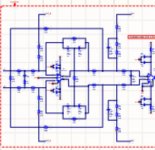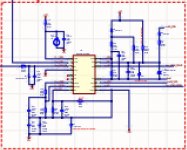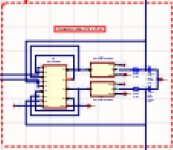Thank you for the "D2KHB-DBF-UCD Combo Ver.1" schematic
Hi NMOS,
I forget to make markup for the Combo.
Ensure you follow the same as in fullbridge.
Regards,
Kartino
Attachments
Hello Reactance
greetings whats the driver IC sI8244W
warm regards
Andrew
That is indeed IRS20957, nothing that you already havent seen before.
However the advancement is inside the controller board that does the following.
- dc monitor voltage +/- up to 100V (programmable 1V steps).
- dc offset +/- (programmable 1V steps).
- +/- current rail monitor 20A (programmable)
- temperature sensors each programmable.
- signal shutdown command output.
- switching modulator frequency monitor.
- 4-wire fan output + Fan RPM monitor.
- solid state relay. (will upgrade to x2 for full bridge application)
- spi control and communication. (I2C "master mode" is a dog to get right on a PIC16F18857)
- speaker voice coil temperature monitor.
- low frequncy sinewave DDS to test subwoofers.
As Eva said: Sound is speaker things!
And you just talk about utility.
For me, it doesn't fancy. Only to show it different. Again as Eva said, everybody want to make something big. 😀
And dont forget, you copy Ncore input and Eurolive powerstage. At least it looks similar.
And you just talk about utility.
For me, it doesn't fancy. Only to show it different. Again as Eva said, everybody want to make something big. 😀
And dont forget, you copy Ncore input and Eurolive powerstage. At least it looks similar.
Last edited:
By the way this double feedback is totally rubbish you use, who uses pre and post feedback today? oh you. why? you dont understand how to setup poles and zeros, neither do you understand the 2nd, 3rd order harmonics they generate and cause instability notably cause your control loop uses random part values. its a lucky packet and box of chocolates you never know what you getting.
so you randomly select values, until they work and "become stable during startup" with werid hiss issues and artifacts like start-up problems and claim its some revolution when you fix it, I would caution anyone who uses your stuff as the orginal poster found out the hard way, toxic high part overcomplicated schematics and ideas you trying to keep up with us, you clearly looking for validation and trying to show people here you some kind of pro at this but all you doing is looking at establishing your dirty brand. hahah!
so you randomly select values, until they work and "become stable during startup" with werid hiss issues and artifacts like start-up problems and claim its some revolution when you fix it, I would caution anyone who uses your stuff as the orginal poster found out the hard way, toxic high part overcomplicated schematics and ideas you trying to keep up with us, you clearly looking for validation and trying to show people here you some kind of pro at this but all you doing is looking at establishing your dirty brand. hahah!
Attachments
Last edited:
I am done with you.
I prove it, you have nothing to show.
Double feedback is still used by B&O, don't you know?
It is a choice.
I give it free. I sell nothing. The double feedback is made as simple imrovement quality from standard I&R design and proven giving a lot of sound quality improvement.
You are nobody here. Even you dont have any single amp singing. Me, our design have been thousands made by DIYers, in Indonesia, Malaysia, Brunai, Philippines and yes, many people from India have copied also. Madagascar, Germany, Mexico, and Cuba they are start to learn class D in our group.
What about you?
You want curve? What curcve? a 400kHz curve?
Class D UcD superlite test at 400kHz switching - YouTube
I prove it, you have nothing to show.
Double feedback is still used by B&O, don't you know?
It is a choice.
I give it free. I sell nothing. The double feedback is made as simple imrovement quality from standard I&R design and proven giving a lot of sound quality improvement.
You are nobody here. Even you dont have any single amp singing. Me, our design have been thousands made by DIYers, in Indonesia, Malaysia, Brunai, Philippines and yes, many people from India have copied also. Madagascar, Germany, Mexico, and Cuba they are start to learn class D in our group.
What about you?
You want curve? What curcve? a 400kHz curve?
Class D UcD superlite test at 400kHz switching - YouTube
Last edited:
Also, on the point of a copy and paste orgin story, no not even these commerial sources you claim are authentic they copies too (we all are) let me clarify something son, early NCORE development started here locally at my local University in South Africa dont believe? want evidence? read the Analogue Class-D Audio Amplifier Using Z-Domain Methods (Kemp, Pieter Stephanus) "Kemp paper" and see the control loop and math construct the roads for class-d you using today (and NCORE). You know who features on this paper too? Bruno Putzeys, the history of class-d amplifier structures extends far beyond your amplifiers made for indonesian parties and purple vanity fairs.
You are fighting with topics published 10 years ago! we have moved on.
The design of an analogue class-D audio amplifier using Z-domain methods
You are fighting with topics published 10 years ago! we have moved on.
The design of an analogue class-D audio amplifier using Z-domain methods
Last edited:
By the way this double feedback is totally rubbish you use, who uses pre and post feedback today? oh you. why? you dont understand how to setup poles and zeros, neither do you understand the 2nd, 3rd order harmonics they generate and cause instability notably cause your control loop uses random part values. its a lucky packet and box of chocolates you never know what you getting.
so you randomly select values, until they work and "become stable during startup" with werid hiss issues and artifacts like start-up problems and claim its some revolution when you fix it, I would caution anyone who uses your stuff as the orginal poster found out the hard way, toxic high part overcomplicated schematics and ideas you trying to keep up with us, you clearly looking for validation and trying to show people here you some kind of pro at this but all you doing is looking at establishing your dirty brand. hahah!
This is video of the test of double feedback based amplifier:
CLASS-D AMPLIFIER D900 DOUBLE FEEDBACK - YouTube
I am not dreamer like you.
Also, on the point of a copy and paste orgin stories, no not even these commerial sources you claim are authentic are they copies too (we all are) let me clarify something son, early NCORE development started here locally at my local University in South Africa dont believe? want evidence? read the kemp paper and see the control math construct the roads for class-d you using today. You know who features on this paper too? Bruno Putzeys, the history of class-d amplifier structures extends far beyond your amplifiers made for indonesian parties and purple vanity fairs.
The design of an analogue class-D audio amplifier using Z-domain methods
In fact it is looked similar. Whatever you say.
According to yourself, all looked similar are copied from others.
Doesn't you agree on this?
And what the hell.
That paper was made on 2012.
This is serious issue.
Do you mean Bruno use his student's idea?
This Wahyu Eko Romadhon fellow is part of the fan boy club spreading the dirty designs sorry no.
So that all what you say is not correct.
The amp has been tested, dummy and as Eva said, it deliver good sound.
The amp has been tested, dummy and as Eva said, it deliver good sound.
This is also double feedback, made by someone else.
Uji Balap Class D Lexus 2000D dual feedback dengan speaker watt besar - YouTube
There are so many people post class D from Indonesia. I cannot post all here.
Uji Balap Class D Lexus 2000D dual feedback dengan speaker watt besar - YouTube
There are so many people post class D from Indonesia. I cannot post all here.
Last edited:
- Home
- Amplifiers
- Class D
- Fullbridge D class I could not solve the problem




